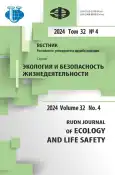Carbon footprint of the energy sector
- 作者: Gainullina L.R.1, Fasykhov A.R.1, Timerbaev N.F.2, Ibragimova V.R.2
-
隶属关系:
- Kazan State Power Engineering University
- Scientific and Technical Center for Alternative Energy
- 期: 卷 32, 编号 4 (2024)
- 页面: 365-384
- 栏目: Industrial Ecology
- URL: https://journal-vniispk.ru/2313-2310/article/view/324063
- DOI: https://doi.org/10.22363/2313-2310-2024-32-4-365-384
- EDN: https://elibrary.ru/MYOVNQ
- ID: 324063
如何引用文章
全文:
详细
The world's attention is focused on the anthropogenic component of climate change. The energy sector (77.9%) makes a significant contribution to these changes. Russia, has natural gas, oil and coal as a source of energy production, while the issue of using low-carbon resource base, application of new technologies of carbon capture and utilization, use of renewable energy sources remains relevant. The purpose of this study is to analyze the carbon footprint of generating enterprises and various energy sources, and to determine the way of development of the use of low-carbon sources, such as nuclear power plants and hydroelectric power plants, the application of new technologies in the heating system, refrigerant utilization technologies, secondary energy resources, etc. Results: The carbon footprint of the energy sector has been considered for Scope 1 and Scope 2. The analysis of the carbon footprint of generating enterprises (Scope 1) showed that the largest contribution is made by fossil fuel power plants with specific CO2 emission rates of 450-1000 g/kWh. Hydroelectric power plants belonging to the category of renewable energy power plants (RES) due to large total methane emissions from reservoirs are in the second place (24 g/kWh), ahead of nuclear power plants with specific emission rate of 12 g/kWh. Wind power plants (11 g/kWh) are close to nuclear power plants in terms of carbon neutrality. The ambiguous position of one of the leaders of green energy, solar power plants (48 g/kWh) is associated with the stage of utilization of the equipment used. Specific emission values of Scope 2 category are also given. Based on the results of the analysis of the energy sector of Scope 1 and 2, recommendations for reducing the carbon footprint are given.
作者简介
Leysan Gainullina
Kazan State Power Engineering University
编辑信件的主要联系方式.
Email: gainullina7819@mail.ru
ORCID iD: 0000-0001-5414-7647
Candidate of Technical Sciences, Associate Professor of the Department of Engineering Ecology and Labor Safety
51 Krasnoselskaya St, Kazan, 420066, Russian FederationAidar Fasykhov
Kazan State Power Engineering University
Email: fara.388@mail.ru
Postgraduate student, Department of Engineering Ecology and Labor Safety 51 Krasnoselskaya St, Kazan, 420066, Russian Federation
Nail Timerbaev
Scientific and Technical Center for Alternative Energy
Email: cpekgeu@gmail.com
ORCID iD: 0000-0001-9170-2056
Doctor of Technical Science, Director
85B Dekabristov St, Kazan, 420034, Russian FederationVictoria Ibragimova
Scientific and Technical Center for Alternative Energy
Email: cpekgeu@gmail.com
Deputy Director 85B Dekabristov St, Kazan, 420034, Russian Federation
参考
- Ermakova MS. Emissions of greenhouse gases: laying them out on the shelf. Ecology of production. February 2021:98–105. (In Russ.). Available from: https://news.ecoindustry.ru/wp-content/uploads/2021/02/Ermakova.pdf (accessed: 25.12.2023).
- Umnov VA, Korobova OS, Skryabina AA. Carbon footprint as an indicator of the impact of the economy on the climate system. RSUH/RGGU BULLETIN. Series Econimics. Management. Low. 2020;2:85–93. (In Russ.). http://doi.org/10.28995/2073-6304-2020-2-85-93
- Nikonova RA, Dryagina DR. Protection of the environment during the operation of thermal power plants. Modern innovations. 2018;(3):12–15. (In Russ.).
- Yihsuan Wu, Jian Hua. Investigating a Retrofit Thermal Power Plant from a Sustainable Environment Perspective – A Fuel Lifecycle Assessment Case Study. Sustainability. 2022;14(8):4556. http://doi.org/org/10.3390/su14084556
- Silaeva PY, Silaev AV. Peculiarities of dispersion of nitrogen dioxide emissions by the energy complex enterprises and their impact on the population of megapolises. RUDN Journal of Ecology and Life Safety. 2018;26(1):63–72. (In Russ.). http://doi.org/10.22363/2313-2310-2018-26-1-63-72
- Plotnikova IN, Volodin SA, Kochneva YuYu, Salyakhova AR. Current issues of decarbonization. Salakhov MH, Tagirov MS. (eds.). Publishing house “FEN” of the Academy of Sciences of the Republic of Tatarstan; 2021. 56 p. (In Russ.).
- Vaulin I. Hydropower confirms the status of carbon-free. Atomny expert. Series: Ecology. 2020;1–2. (In Russ.). Available from: https://atomicexpert.com/carbonless_hydropower (accessed: 25.11.2022).
- Bazhin NM. Methane in the environment. Ecology. A series of analytical reviews of world literature. 2010(93):1–56. (In Russ.).
- Tikhonov S. Will nuclear energy become an alternative to windmills. Rossiyskaya Gazeta. Federal issue. 2021(231). (In Russ.). Available from: https://rg.ru/2021/10/07/stanet-li-atomnaia-energetika-alternativoj-vetriakam.html
- Khalilullina AR. Renewable energy sources in the form of geothermal heat pump. Innovation Science. 2019;(2):42–44.
- Hassan FA, Alali Сh, Gainullina LR. Increasing the efficiency of wind farms. iPolytech Journal. 2022;26(2):217–227. (In Russ.). https://doi.org/10.21285/1814-3520-2022-2-217-227
- Hassan Fouad A, Gainullina LR, Timerbaev NF. Methodology to estimate and forecast the average the annual speed and direction of the wind based on wind measurement data. Bulletin of Kazan State Energy University. 2022;14(55):59–68. (In Russ.).
补充文件









